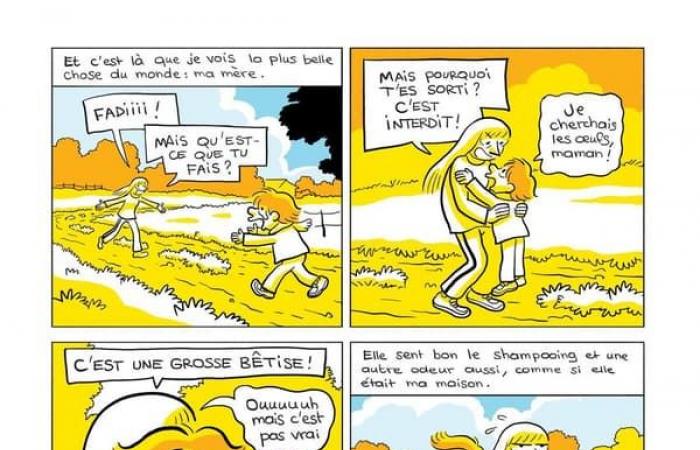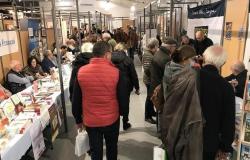In I, Fadi, the stolen brother, A story resembling a waking nightmare, full of visual references to horror cinema, Riad Sattouf delivers the point of view of his little brother kidnapped and raised in Syria by their father.
Extend The Arab of the future and surprise the public once again: this is Riad Sattouf’s new bet with Me, Fadi, the stolen brotherwhere the Grand Prix d’Angoulême recounts the childhood of his younger brother, kidnapped by their father in the early 1990s. A tragic event which pushed him to undertake this comic strip, but which he had not told until now only a part.
For this new series of comics planned in three volumes, Riad Sattouf relied on testimonies from Fadi collected in 2011 and 2012. He describes Fadi’s first memories at Cap Fréhel, in Brittany, while he was in kindergarten. . One day, his father Abdel-Razak kidnaps him. He takes her with him to Syria. His mother and two brothers, who remained in France, did not see him again for 20 years.
From the first scenes, Riad Sattouf recounts a memory which seems to announce the disappearance of young Fadi. One afternoon, Riad and his other brother Yahya trap Fadi during an Easter egg race and leave him alone. The child walks for a long time, without finding any eggs, then gets lost. “I’m lost forever. So I’m still walking…” confides Fadi in this almost dreamlike sequence.
Waking Nightmare
Me, Fadi, the stolen brother is distinguished from The Arab of the future thanks to this narration that resembles a waking nightmare. Some scenes even borrow from the visual codes of horror cinema. “Indeed, there is something of a waking nightmare,” Riad Sattouf confides to BFMTV. “I have always been fascinated by genre cinema, genre literature. Me Fadi is a kind of fantasy story!”
Me Fadi is told from the point of view of the child he was. The reader experiences with Fadi this moment when the carelessness of childhood turns into a nightmare. The characters are hidden in disturbing shadows. The faces are scary. The colors of the previous volumes of The Arab of the futureblue, yellow and red, give way to a green color which gives certain pages a truly distressing tone.
Fadi’s arrival in Syria is one of the scariest sequences that Riad Sattouf has drawn. “(It’s) a dive into another world. Fadi passes through the mirror. I found that it was a good way to reflect Fadi’s psychological state at that moment”, analyzes – he. “Color is also important, its evolution in the book is there to reflect these unconscious changes.”
“Translate the discomfort”
The horrific atmosphere of the story is reinforced by the presence of the color green in certain key scenes. “The color green has a very special place in Me, Fadi. It is a color that, historically, can evoke both life and death, illness and healing. Color almost becomes a character in its own right, which insinuates itself into the most critical scenes to convey this unease,” confirms the designer.
“In the first series of The Arab of the futureI opted for a more restricted palette to illustrate uprooting, with clear breaks. Here in Me, FadiI wanted a different palette, capable of carrying this new tone with a color that evolves on each page without the reader realizing it,” he continues.
If the author claims in interview his wish to “make comics for people who don’t read them”, he also assumes in Me, Fadi his dream of telling stories in the tradition of his models, the masters of fantasy and horror, from the writer HP Lovecraft to the cartoonists Richard Corben and Philippe Druillet. Riad Sattouf had confided his admiration for its authors in volumes 4 and 5 of The Arab of the future.
“Lovecraft influenced me a lot, even in my way of seeing the world, there is something of education in paranoia!”, deciphers the designer. “If you find that this influence is felt in Me, Fadithat makes me very happy. What has always fascinated me in his writings is this idea of an invisible, omnipresent threat, which escapes our understanding, that’s a bit of what Fadi experiences.”
Fear of shadows
From the moment he arrived in Syria, Fadi lived in fear. In his room, the little boy, lit by a night light, spends his nights crying. Shadows on the wall inspire him with night terrors. “The shadows have started to move,” he says alarmed. A fear that increases tenfold during the day in this country where he does not speak the language and whose customs he gradually learns.
Volume 5 of The Arab of the future already featured a large number of terrifying scenes and real or fantastic monsters. A rather unexpected aspect in his work, where humor always prevails over drama. In Me Fadidarkness is omnipresent. For this reason, Riad Sattouf took several years to create this story. “It was a challenge. My brother’s story is something untold, untold,” he told BFMTV last week. What happens next is also untold.
For now, Riad Sattouf refuses to say more for the moment. And to reveal if he is still in contact with this long lost brother. “For a book to work well, you have to keep an element of mystery (…) so as not to break the spell. You will find out when you read the rest.” And reading every month in the magazine Our time the pages of another book tell his mother’s point of view on this story. The title? The Arab of the future, the mother’s book. A story just as poignant as that of Fadi.
Me, Fadi, the stolen brother (1986-1994), volume 1, Riad Sattouf, Les Livres du Futur, 144 pages, 23 euros.







